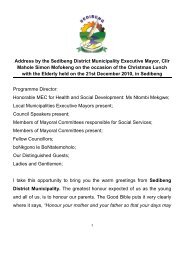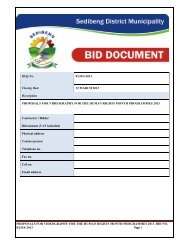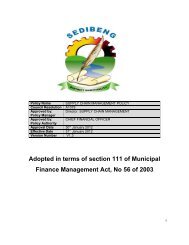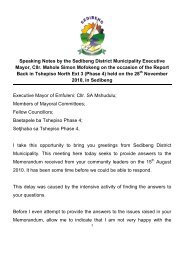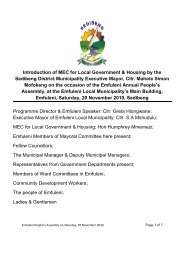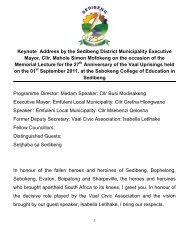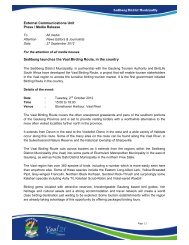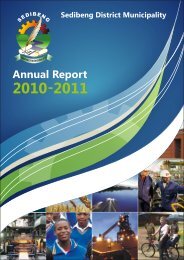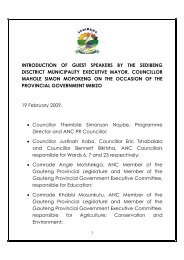Chapter 11 - Sedibeng District Municipality
Chapter 11 - Sedibeng District Municipality
Chapter 11 - Sedibeng District Municipality
Create successful ePaper yourself
Turn your PDF publications into a flip-book with our unique Google optimized e-Paper software.
The transportation of abnormal goods is highly dangerous and has a huge impact on<br />
other road users, communities and infrastructure. Super-loads usually travel at snail’s<br />
pace and traffic officials are requested to accompany vehicles for the duration of the<br />
trip to ensure minimum interruption of traffic flow .<br />
If the vehicle including the load meets one of the follow ing, then it is classified as an<br />
abnormal load: at least 26 ton w eight; at least 2.6 m w idth, or at least 4.3 m height.<br />
Route planning is carried out by the applicant. There is detail planning of the route for<br />
the transportation of the extra-heavy freight through the national road netw ork. Tow ns<br />
and cities along the route are notified in advance. Depending on the magnitude of the<br />
load traffic officials may be required to escorts the abnormal load. Traffic officials will<br />
only escort the load w ithin their municipal boundaries. Therefore, loads traversing<br />
several municipal boundaries and Provinces require involvement of the respective<br />
traffic officials. Further, abnormal loads traversing Provinces require a permit from<br />
each Province.<br />
The criteria for vehicle escort are as follow s:3.3 m w idth – 1 escort; 3.8 m w idth – 2<br />
escort; and 4.8 m w idth – traffic police escort.<br />
In areas w here travelling is difficult and traffic may be severely affected, it is often the<br />
responsibility of the transporter to construct special lay-byes onto w hich the heavy<br />
vehicles are draw n from time to time to allow for passing traffic.<br />
Applicants are required to apply for a permit for each consignment through the<br />
provincial department of transport in Pretoria. The permit details the destination, type<br />
of load carried and the route to be follow ed, and the estimated w eight. The<br />
information must be fairly accurate in order for the traffic officers to approve the<br />
abnormal vehicle and load through the various municipal boundaries. The duration for<br />
the application of a permit varies from one to three days.<br />
The common routes for NATRO from the GautengProvince are N3 (Durban), N1/R59<br />
Cape Tow n, N4 to Botsw ana ultimately Zambia, and N17 to RichardsBay.<br />
The abnormal load can only be transported during w eekday from 6:00 to 18:00, but<br />
not during peak periods. The industry is advocating for the review of this rule w hich is<br />
based on an outdated TRH <strong>11</strong> guideline document. Hence the CSIR and DoT are<br />
currently review ing the TRH <strong>11</strong> guideline document that w ill further improve the<br />
process.<br />
<strong>11</strong>.1.4 Hazardous Materials<br />
Many mineral inputs that are integral factors of industrial production are poisonous,<br />
flammable, explosive, corrosive or in other w ays potentially harmful.Strict government<br />
regulations have been imposed to control the transportation of hazardous materials<br />
and substances. The classification systems for hazardous materials have been<br />
implemented. In doing this, DoT adopted the recommendations of the United Nations.<br />
Vehicles carrying hazardous materials must be identified by the correct signage and a<br />
trained driver must carry documentation to supplement the information on the sign.<br />
The legislation for the transportation of hazardous materials is included in <strong>Chapter</strong> 8<br />
of the National Road Traffic Act, 1996, as well as other additional Sections and<br />
Regulations contained in the Act. The South African Bureau of Standards (SABS) has<br />
SDM DITP, 2008 to 2013 162 31 Aug 2010



